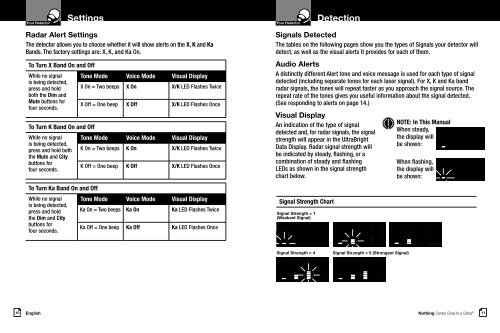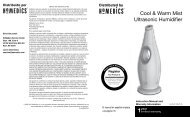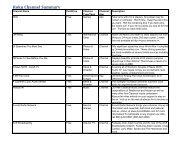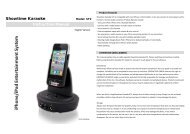ESD 900 - QVC.com
ESD 900 - QVC.com
ESD 900 - QVC.com
Create successful ePaper yourself
Turn your PDF publications into a flip-book with our unique Google optimized e-Paper software.
l<br />
l<br />
l<br />
l<br />
l<br />
l<br />
l<br />
Your Detector<br />
Settings<br />
Your Detector<br />
Detection<br />
Secondary Icons<br />
Intro Operation Customer<br />
Assistance<br />
Radar Alert Settings<br />
Mute buttons Noticefor<br />
Warranty<br />
The detector allows you to choose whether it will show alerts on the X, K and Ka<br />
Bands. The factory settings are: X, K, and Ka On.<br />
To Turn X Band On and Off<br />
While no signal<br />
is being detected,<br />
press and hold<br />
both the Dim and<br />
Tone Mode<br />
X On = Two beeps<br />
Voice Mode<br />
X On<br />
Visual Display<br />
X/K LED Flashes Twice<br />
four seconds.<br />
X Off = One beep X Off X/K LED Flashes Once<br />
To Turn K Band On and Off<br />
While no signal Tone Mode Voice Mode Visual Display<br />
is being detected,<br />
press and hold both K On = Two beeps K On X/K LED Flashes Twice<br />
the Mute and City<br />
buttons for<br />
four seconds.<br />
K Off = One beep K Off X/K LED Flashes Once<br />
To Turn Ka Band On and Off<br />
While no signal Tone Mode Voice Mode Visual Display<br />
is being detected,<br />
press and hold Ka On = Two beeps Ka On Ka LED Flashes Twice<br />
the Dim and City<br />
buttons for<br />
four seconds.<br />
Ka Off = One beep Ka Off Ka LED Flashes Once<br />
Secondary Icons<br />
Intro Operation Customer<br />
Assistance<br />
Signals Detected<br />
Warranty<br />
The tables on the following pages show you the types of Signals your detector will<br />
detect, as well as the visual alerts it provides for each of them.<br />
Audio Alerts<br />
A distinctly different Alert tone and voice message is used for each type of signal<br />
detected (including separate tones for each laser signal). For X, K and Ka band<br />
radar signals, the tones will repeat faster as you approach the signal source. The<br />
repeat rate of the tones gives you useful information about the signal detected.<br />
Notice<br />
(See responding to alerts on page 14.)<br />
Visual Display<br />
An indication of the type of signal<br />
detected and, for radar signals, the signal<br />
strength will appear in the UltraBright<br />
Data Display. Radar signal strength will<br />
be indicated by steady, flashing, or a<br />
<strong>com</strong>bination of steady and flashing<br />
LEDs as shown in the signal strength<br />
chart below.<br />
Signal Strength Chart<br />
Signal Strength = 1<br />
(Weakest Signal)<br />
X/K Ka L V/S<br />
lll<br />
lllll<br />
C<br />
X/K Ka L V/S<br />
lll<br />
lllll<br />
C<br />
NOTE: In This Manual<br />
When steady,<br />
the display will<br />
be shown:<br />
When flashing,<br />
the display will<br />
be shown:<br />
X/K Ka L V/S<br />
lll<br />
lllll<br />
C<br />
X/K Ka L V/S<br />
zzz<br />
zzzzz<br />
X/K Ka L V/S<br />
zzz<br />
zzzzz<br />
Signal Strength = 4<br />
X/K Ka L V/S<br />
Signal Strength = 5 (Strongest Signal)<br />
X/K Ka L V/S<br />
lll<br />
lllll<br />
C<br />
lll<br />
lllll<br />
C<br />
10<br />
English<br />
Nothing Comes Close to a Cobra ® 11

















